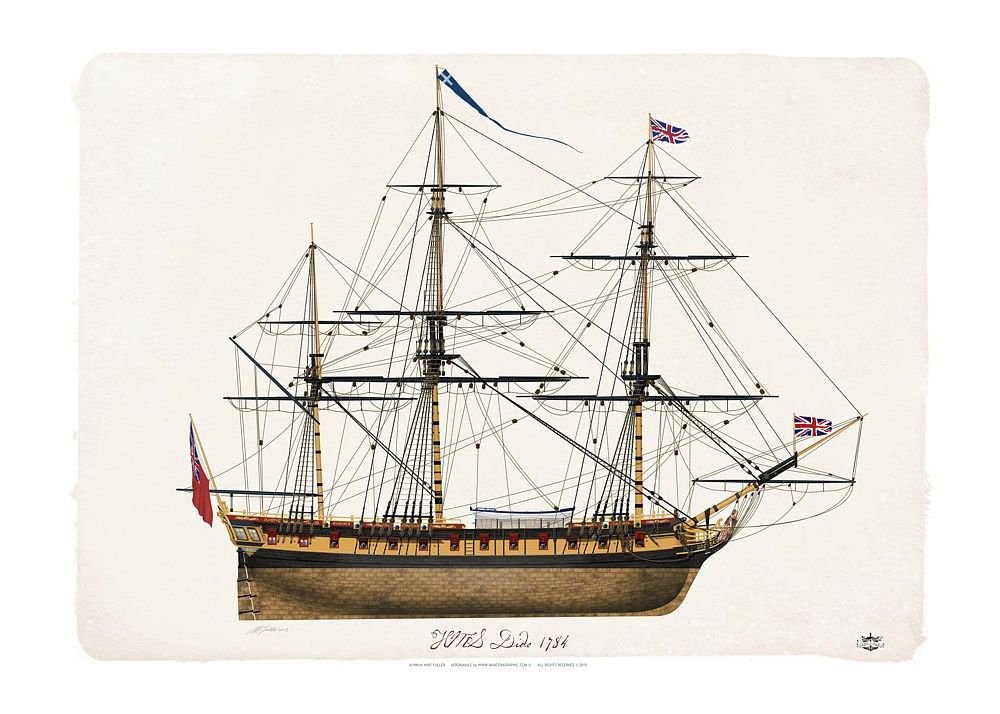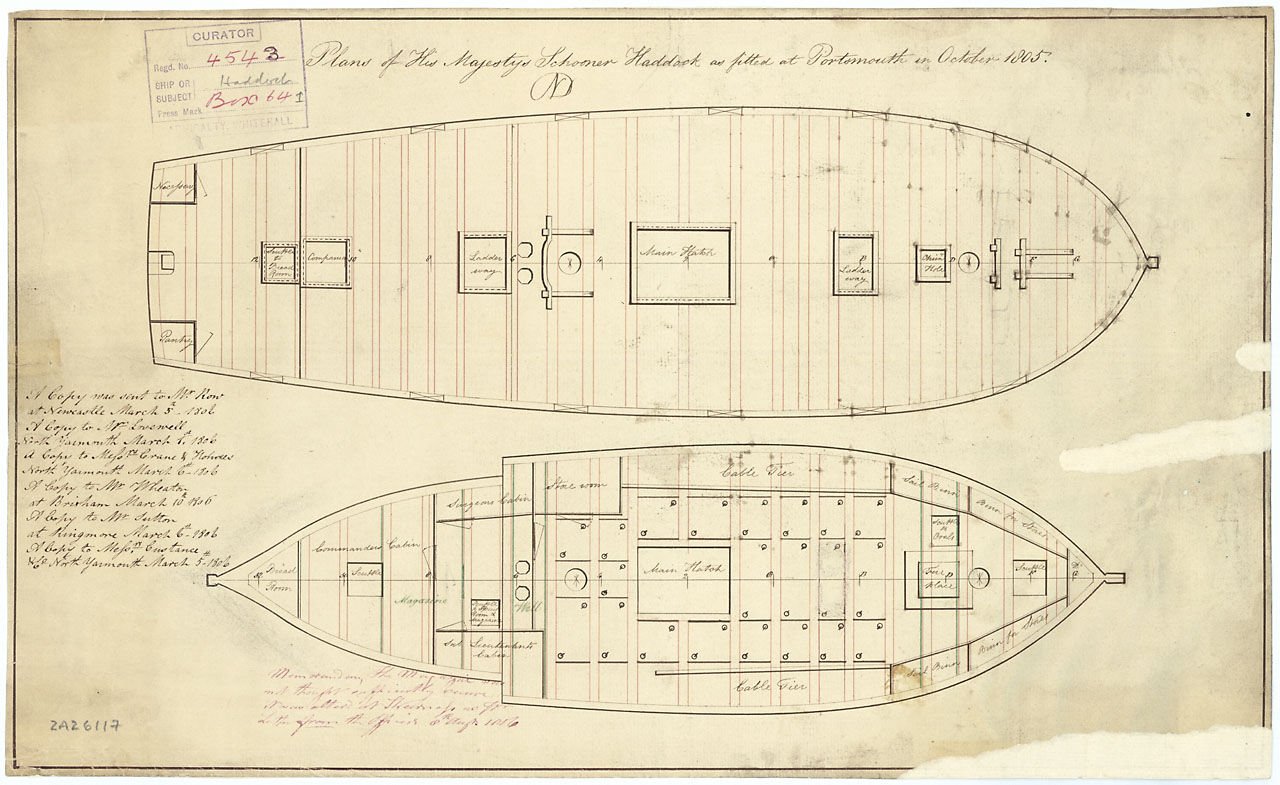
Mr. Hornblower
Members-
Posts
16 -
Joined
-
Last visited
Content Type
Profiles
Forums
Gallery
Events
Everything posted by Mr. Hornblower
-
Almost there, Eamonn, you'd better send the press gang ashore for some hands! Rigging is looking exquisite. It's way beyond me, I'll say. Cheerio, Caleb
- 1,039 replies
-
- ballahoo
- caldercraft
-
(and 2 more)
Tagged with:
-
Wizard show! Very good attention to detail, I must say. Cheerio, Caleb
- 1,039 replies
-
- ballahoo
- caldercraft
-
(and 2 more)
Tagged with:
-
A fine pair of anchors, indeed, Eamonn! The detail is incredible, just like the real thing, eh? Keep up the excellent work. Cheerio, Caleb
- 1,039 replies
-
- ballahoo
- caldercraft
-
(and 2 more)
Tagged with:
-
I'm glad to keep it coming.... just a little more, eh? I don't know if you have seen these before, but here are the original plans for the Ballahoo class, in particular the HM Schooner Haddock (1805). When, may I ask, was that painting completed? As far as I was aware, the Ballahoo's were not tops'l schooners, but then I don't think there are any original illustrations showing the masts, so it is a matter open for debate I think all the relevant specifications of the vessel are on the plans, but let me know if they are difficult to read and I will post them. Cheerio, Caleb
- 1,039 replies
-
- ballahoo
- caldercraft
-
(and 2 more)
Tagged with:
-
Eamonn, Great piece of art, thanks. The Ballahoo class was an attempt by the Admiralty to harness the expertise of the Burmudian shipbuilders, who were renowned for their fast sailing craft, the Burmuda sloops in particular. The Admiralty ordered twelve vessels on June 23, 1804 and a further six on December 11, 1805. They were all constructed from Bermuda cedar, which was durable and light and it did not require seasoning. It was highly resistant to rot and marine borers, giving the ships a potential lifespan of twenty years, even in the worm infested waters of the Caribbean and Chesapeake. Ballahoo herself was launched in January 1804, by Goodrich & Co. Bermuda, and commissioned under Lieutenant William Shepheard. On August 4, 1807, Ballahoo, under the command of Lieutenant Murray, with the schooner Laura (10), captured the French letter of marque Le Rhone of six 6 pounder guns and twenty-six men. Ballahoo, now under Lieutenant Norfolk King, was captured by the 5 gun American privateer Perry on April 29, 1814. The chase took about an hour and the fight lasted ten minutes. At the time of capture, Ballahoo had two of her carronades stowed below and a reduced crew of thirteen. There, some brief information on Ballahoo and her service. I hope it is useful, and if not, interesting at least Cheerio, Caleb P.S. Sorry to highjack the thread!
- 1,039 replies
-
- ballahoo
- caldercraft
-
(and 2 more)
Tagged with:
-
Eamonn, you are right about the Ballahoo's handling. The extra weight of the carronades on deck also attributed greatly to their terrible balance and often had to be stowed below. William James wrote rather scathingly of their sailing characteristics.... "Their very appearance as "men of war" raised a laugh at the expense of the projector. Many officers refused to take the command of them. Others gave a decided preference to some vessels built at the same yard, to be employed as water-tanks at Jamaica. Moreover, when sent forth to cruise against the enemies of England....these "king's schooners" were found to sail wretchedly, and proved so crank and unseaworthy, that almost every one of them that escaped capture went to the bottom with the unfortunate men on board." A most sad conclusion for such a fine looking vessel. Still the Ballahoo makes a brilliant model Cheerio, Caleb
- 1,039 replies
-
- ballahoo
- caldercraft
-
(and 2 more)
Tagged with:
-
I have been reading through this build from the beginning and must say that you have done a wonderful job so far! She definitely appears an elegant vessel. I too, am looking forward to seeing her in commission. Go Ballahoos! Cheerio, Caleb
- 1,039 replies
-
- ballahoo
- caldercraft
-
(and 2 more)
Tagged with:
-
Excellent build, Keith! It seems a very neat little vessel; would you recommend it to others for their first wooden build also? I attempted a scratch-build of HM Cutter Alert (1777), but I am now thinking I should start out with a simple kit first. Best of luck with it all, hope to see more soon! Caleb
- 28 replies
-
- ballahoo
- caldercraft
-
(and 1 more)
Tagged with:
-
Good morning Gentlemen, Well, for those of you who may not have read my previous thread (below), this is my first attempt at a scratch-build, using Goodwin's (extremely helpful) guide for the Cutter Alert of 1777. I have drawn out each individual scantling/rib (whatever you may call it) on paper, then card, using the plans illustrated in Goodwin's guide. If using the traditional method of paper/pencil, be sure to have a waste paper basket nearby I watched a video of a card build of the Alert (this one manufactured by Shipyard models), just to see the method of construction and how to go about it. Each scantling was then glued to the main section using PVA. So, as you gentlemen see below, I have now begun this wild project and so far, I am quite pleased with it. I look forward to hearing any advice you chaps may have for me. Cheerio, Caleb
-
No worries at all Craig, we're all learning new things here I'm pretty sold on the HMS. Alert of 1777, now that I have 129 pages of plans solely on that ship! Just have to work out how to draw up my own bulkheads, should be an interesting exercise indeed. Bruce do you have any advice on how you measured your own bulkheads? I may be looking at at a scale of 1/90. Will keep you informed. Cheers, Caleb
-
Hello All, I thank you all very much for your welcomes and replies. I had two vessels in mind, firstly the Cutter Sandwich of 1805 (same ship as the Sandwich of 1798), or the Entreprenante of 1799. I do not know of any pictures, models, illustrations of Sandwich to actually exist, but you chaps may be able to tell me otherwise. I have just acquired the plans for the Alert of 1777, but as Bruce said, there is a difference between plans and bulkhead/rib templates! I was hoping for a template of sorts. Another thing to let you all know: as this is my first scratch build, I have decided on doing a card/paper model, similar to that of the Alert by Shipyard models. I do not have all the timber machinery, but I have always enjoyed making things from cardboard, so I will try my hand at a card/paper model (with extras such as dowel for mast/bowspirit etc). Thanks again. Cheers, Caleb
-
Hello Gentlemen, I am the new 'Middy' on the block from Australia! I am attempting a scratch-build of a Royal Navy Cutter (circa 1790's) and I am wondering if anyone has a template I could use for the hull structure/ribbing? It would save me a lot of work and time if this was obtainable and I would have peace of mind that the hull is entirely symmetrical, rather than trying to measure and draw my own. I thank you in advance. Cheerio, Caleb
About us
Modelshipworld - Advancing Ship Modeling through Research
SSL Secured
Your security is important for us so this Website is SSL-Secured
NRG Mailing Address
Nautical Research Guild
237 South Lincoln Street
Westmont IL, 60559-1917
Model Ship World ® and the MSW logo are Registered Trademarks, and belong to the Nautical Research Guild (United States Patent and Trademark Office: No. 6,929,264 & No. 6,929,274, registered Dec. 20, 2022)
Helpful Links
About the NRG
If you enjoy building ship models that are historically accurate as well as beautiful, then The Nautical Research Guild (NRG) is just right for you.
The Guild is a non-profit educational organization whose mission is to “Advance Ship Modeling Through Research”. We provide support to our members in their efforts to raise the quality of their model ships.
The Nautical Research Guild has published our world-renowned quarterly magazine, The Nautical Research Journal, since 1955. The pages of the Journal are full of articles by accomplished ship modelers who show you how they create those exquisite details on their models, and by maritime historians who show you the correct details to build. The Journal is available in both print and digital editions. Go to the NRG web site (www.thenrg.org) to download a complimentary digital copy of the Journal. The NRG also publishes plan sets, books and compilations of back issues of the Journal and the former Ships in Scale and Model Ship Builder magazines.



